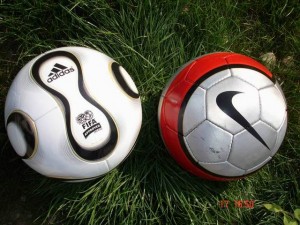 Simply put, Ambush marketing occurs when a company signs on to sponsor an event as official sponsor, and a rival hijacks the mind space through backdoor means. It is a concept that describes the actions of companies who seek to associate themselves with a sponsored event without paying the organizers. The ambush consists of giving the impression to consumers that the ambusher is somehow affiliated with the event. Ambush marketing can provide some, if not most, of the benefits of a legitimate, paid-for sponsorship at relatively little cost.
Simply put, Ambush marketing occurs when a company signs on to sponsor an event as official sponsor, and a rival hijacks the mind space through backdoor means. It is a concept that describes the actions of companies who seek to associate themselves with a sponsored event without paying the organizers. The ambush consists of giving the impression to consumers that the ambusher is somehow affiliated with the event. Ambush marketing can provide some, if not most, of the benefits of a legitimate, paid-for sponsorship at relatively little cost.
See the Nike ad here
A recent article in the The Sydney Morning Herald certainly highlights as how clever you have to be to gain an advantage when you use ambush as a strategy.
Nike commits a professional foul on adidas @ The Sydney Morning Herald

The official World Cup sponsor adidas is losing out to Nike’s back-door marketing, which is proving a bigger hit with fans, writes Julian Lee.
Nike’s global ambush marketing of the World Cup appears to be paying off, latest research indicating it is beating its rival, adidas, in connecting with soccer fans and consumers.
Great news for Nike, which has not paid a cent in sponsorship to soccer’s governing body, FIFA, and bad news for adidas, which has stumped up an estimated $US351 million ($402 million) for the rights to the 2010 and 2014 World Cup tournaments.
Two separate surveys show Nike is emerging as the most recognised company of the World Cup.
Nike’s strategy of pouring money that it was unable to spend on sponsorship into an ambush featuring a multimillion-dollar advertising campaign appears to be paying off.
Its Write The Future ad featuring a cast of players such as England’s Wayne Rooney and Portugal’s Cristiano Ronaldo has been viewed more than 16 million times on YouTube. Nine of the 32 World Cup teams, including Australia, are wearing Nike kit – just three less than those used by the official sponsor, adidas.
To cap it all, adidas’s woes have been compounded by news that players have criticised the ball it made for the tournament as being too light and unpredictable, a flaw that may affect its plans to sell 50 million of them worldwide.
Almost a third of the online buzz around the World Cup in the month before the tournament was focused on Nike, twice as high as the official sponsor adidas, the researcher Nielsen found.
A local study by the media-buying agency MEC a month before that found 17 per cent of people canvassed recalled Nike as a sponsor, compared with 15 per cent for adidas.
Even though other sponsors, namely Visa, Coca-Cola and Sony, fared better in connecting with viewers and fans, it has raised the question – why bother paying a fortune to be a sponsor when you can just ambush the event?
Pete Blackshaw, the executive vice-president of digital strategy at Nielsen, said: “This study shows that compelling, savvy marketing can establish this sort of connection [with] consumers without having to write that expensive sponsorship cheque.”
The adidas Australia marketing director, Simon Millar, said the massive investment in the World Cup would be justified. Its sales during the last tournament reportedly ran to $US1.5 billion.
”When you look at the level of success for our global sales of football compared to theirs, it shows of course it is worthwhile. Nike has been forced to go through the only door that is open to them. We have a 40-year relationship with FIFA so they were left with no choice.”
There is just a 7 per cent gap between adidas, the global market leader of soccer-related sporting merchandise, and the No. 2 , Nike, a relative latecomer to the soccer market during the 1994 World Cup in the US.
Nick Callander of the marketing agency Ignition said Nike was smart with its timing – its ad was released last month. ”There’s something to be said about getting in early and getting that immediate hit before all the rest of the marketing begins because by the time the rest of the sponsor campaigns come around it all starts to look like wallpaper.”
And, in what FIFA may now see as as an oversight, Nike signed up as a “broadcast sponsor” with the local rights holder in Australia, SBS, in effect giving it preferential placement of its ads around the coverage.
The results have also highlighted how, despite FIFA’s best efforts at aggressively protecting the intellectual property rights of its sponsors, the internet and mobile phone marketing has left the back door open for savvy marketers.
Sweetian Ang, the strategy director at MEC, said FIFA’s speedy ejection from a stadium of 35 women who wore bright orange mini-dresses to promote a Dutch beer showed the organisation was quick to protect its sponsors’s rights, in this case Budweiser. The number of infringements by ambush marketers at this year’s tournament is expected to exceed the 3000-odd that took place in 2006.
”FIFA has become very good at controlling what is happening on the ground but they are still coming to terms with online,” Mr Ang said. ”As more brands move online they can’t exercise that level of control.”
As long as a brand does not attempt to pass itself off as a sponsor or use the FIFA or World Cup branding, it is free to roam around the internet, as Nike has done with its Write the Future ad. A spokeswoman for Nike Australia, Kilee Hughes, said greater emphasis was placed on online marketing this year, the company launching a Facebook site in Australia and putting the ad on ”social hubs” and on sites such as YouTube.
”We put a lot of thought into it and it [the campaign] has exceeded our expectations,” she said. Inevitably sponsorship experts have defended headline sponsorship events.
Brian Levine of the sponsorship consultant Blinc International said: ”Brand awareness isn’t everything. Events like these can be used for competitions or to drive sales or for things like merchandise, so branding is just one of a number of factors.”
Chintan is the Founder and Editor of Loyalty & Customers.





Great info comes from the great writer .. I hope you like my compliment .. thanks for giving me great info 🙂